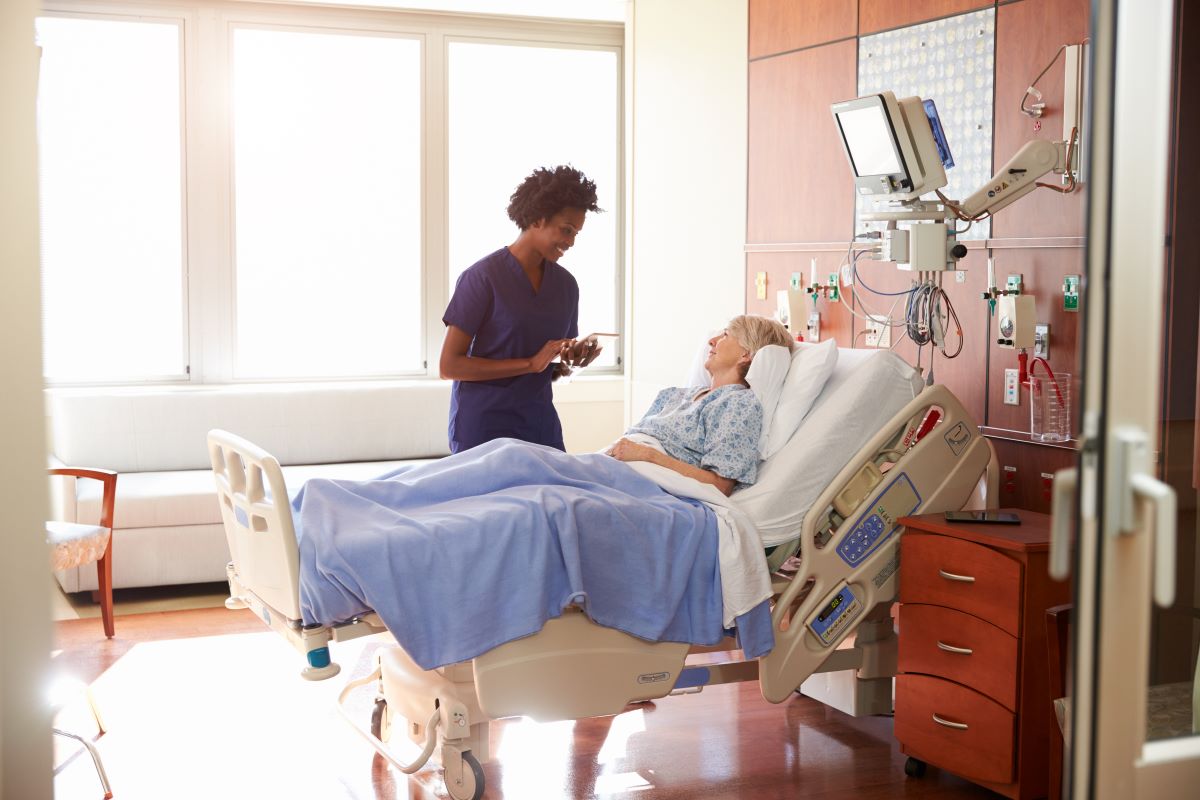Designing a Patient’s Room for Safety: 5 Best Practices

Patient safety is a key priority for healthcare staff. What you might not know, however, is that focusing on patient room design goes a long way toward improving patient safety, as well as patient and staff satisfaction.
Healthcare leaders have so many different things to consider when planning a patient’s room. From layout to specific feature choices, decisions can be made to optimize patient safety and contribute to staff efficiency. Whether you’re just starting out on the design of your facility, or looking to upgrade and update your space, there are many ways to improve patient well-being through high-quality room design.
Why Is it Important to Consider Safety When Planning Hospital Patient Room Design?
When planning or remodeling a healthcare facility, many designers incorporate modern, visually appealing, and highly-technical features into their patient room designs. However, these individuals might not be aware of how their preferences could affect patient safety outcomes.
Hospital room layout, size, and feature choices can impact the following nurse-sensitive quality indicators:
- Patient fall rates
- Rapid response activation time
- Infection transmission rates
- Pressure injury incidence
- Patient and staff satisfaction scores
What Are Some Common Hazards of a Patient’s Room?
In hospitals, clinics, and health centers, clinicians make huge efforts to keep patients free from injury and infection while receiving care. Despite their best attempts, some safety issues still arise because of room-related hazards outside of staff control.
When establishing patient room design standards at your facility, it’s important to consider the following design factors that could place patient safety at risk:
- Cords, wires, and IV tubing laying in walking areas, increasing fall risk
- Storage areas and tables being installed far from the patient’s bed or chair
- Poorly draining sinks, leading to wet and slippery floors
- Empty soap or hand sanitizer dispensers, increasing risk for infection
- Cluttered, overcrowded rooms that are difficult to navigate
So, what are ways to ensure a patient’s room is safe? It might be difficult to know where to start, so we’ve provided five ideas to help get you started.
5 Ideas for Safer Hospital Room Design
Considering these factors can help your facility meet nurse-sensitive indicator benchmarks for safety, improve patient satisfaction, and alleviate burdens commonly experienced by bedside staff.

1. Design Rooms Around Maintaining Patient Privacy
In the hustle and bustle of healthcare, it’s easy to see why patients would prefer private rooms versus shared rooms. Individual rooms allow space for family visitation, sensitivity toward patient confidentiality, and a general sense of serenity within the space. Private rooms also prioritize patient safety by allowing space for essential staff members and their devices to navigate around a patient’s bed.
Each room could be outfitted with a personalized information board for the patient, with goals of care, names of staff members, and medication names for easy reference. Private rooms help boost patient satisfaction scores by helping the patient feel ownership of their space while undergoing treatment.
2. Install Sliding Glass Doors to Minimize Noise
Sliding glass doors that separate the room from the hallway can help create a safer environment for patients, above and beyond the usual hospital patient room requirements. Being able to see into the patient’s room allows staff members to visualize the individual, along with monitors and devices, from the nursing station or hallway.
Outfitting sliding doors, as opposed to clumsier hinged doors, also helps keep the unit quieter. For private consults and times of exposure, the patient could use a curtain to temporarily provide coverage from potential onlookers.
3. Place Sinks and Hand Gel in Every Room
Including a sink and hand sanitation gel in every room can significantly help manage infection rates. Ideally, the sink would be placed near areas of highest contamination — usually, this is next to the toilet or trash can. A sink with a deep basin, off-center drain, and minimal counter space minimizes splashing and prevents harmful bacteria from growing.
The hand gel should be placed near the door, ideally both inside and directly outside of the room, to ensure all staff members entering and exiting the room have clean hands before proceeding to their next task. Motion-sensored dispensers help to decrease bacteria colonization on touch points and limit the spread of contaminants from room to room.
4. Utilize Wireless Call Bells to Limit Tripping Hazards
All patient rooms in hospitals and other medical facilities, from acute care inpatient rooms to skilled nursing residences, employ the use of a patient call bell. However, with a long dangling cord, most call bells can get in the way of patient care, can become a fall hazard, and are limited by cord length.
When outfitting each patient room, hospital administrators should consider implementing the use of a modern wireless call bell. With Bluetooth technology and centralized monitoring capability, your patients can call from bed, the bathroom, or the hallway with any urgent needs. Preventing independent transfer and toileting-related falls is just one key advantage of installing wireless call bells in each room.
5. Keep Supplies in Easy-to-Reach Locations
In the case of an emergency, the last thing you want is for your staff to be fumbling around while trying to find or reach critical equipment. Consider placing frequently used items like syringes, saline flushes, and lab tubes in low, easy-to-reach cabinets for quick access in the patient’s room. If possible, keep these items unlocked and well stocked. Avoid placing items in high, hard-to-reach shelves, or in a far-off supply room. Having supplies handy and easy to retrieve is imperative during a code situation.
Additionally, standardizing the locations of these supplies across units and facilities makes it easier for staff who might float between specialties. Labeling drawers with supply contents or creating a patient room equipment list for locating items in each room is another way to help staff members treat each patient efficiently.
Find More Ways to Promote Patient Safety
Focusing on the design of the patient’s room is one of the many ways healthcare facilities can enhance patient safety. Want to learn more? Don’t miss out; IntelyCare’s free newsletter provides even more ways to improve patient safety and satisfaction.



